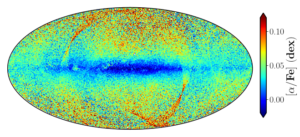
Figure: Map of the Alpha elements as seen by Gaia. Credits: ESA
Dr. Sara Vitali “Chemical abundances as efficient tracers for studying galactic evolution”
Giovedì 14 Dicembre ore 11.00 – Sala Seminari Villa Magliola INAF-OATo
SEGUI IL SEMINARIO IN STREAMING
Abstract
With the detailed measurements available for our Galaxy and the local volume, the Milky Way and its satellites are a unique laboratory for the galactic archaeology field, which is trying to reconstruct the galactic evolution history from fossil records. In this panorama, spectroscopy is one of the primary tools to explore the physics of the Universe. This field, encompassing a wide range of subjects from detecting exoplanets to studying the expansion of the Universe, has begun collecting massive data-sets, yielding remarkable outcomes. Among the various applications of spectroscopy, the study of stellar abundances is of primary importance. In fact, the chemical information enclosed in a stellar spectrum is extremely informative as galactic chemical evolution tells us that elemental abundance ratios can be used to trace star formation history between stellar generations. This holds true for both our galaxy and its satellites.
My talk will be about the application of stellar spectroscopy to investigate chemical evolution. I will present a spectroscopic dataset that I assembled to characterize the stellar populations of the Sagittarius dwarf spheroidal galaxy. Additionally, I’ll explore the potential (and limitations) of chemical tagging a subject I’ve investigated using various spectroscopic datasets. Despite their diversity, the common aim is to understand the most effective ways to use stellar spectroscopy and chemical abundance ratios for retracing the chemical evolution within distinct galactic environments.
Local contact: Mario Damasso

